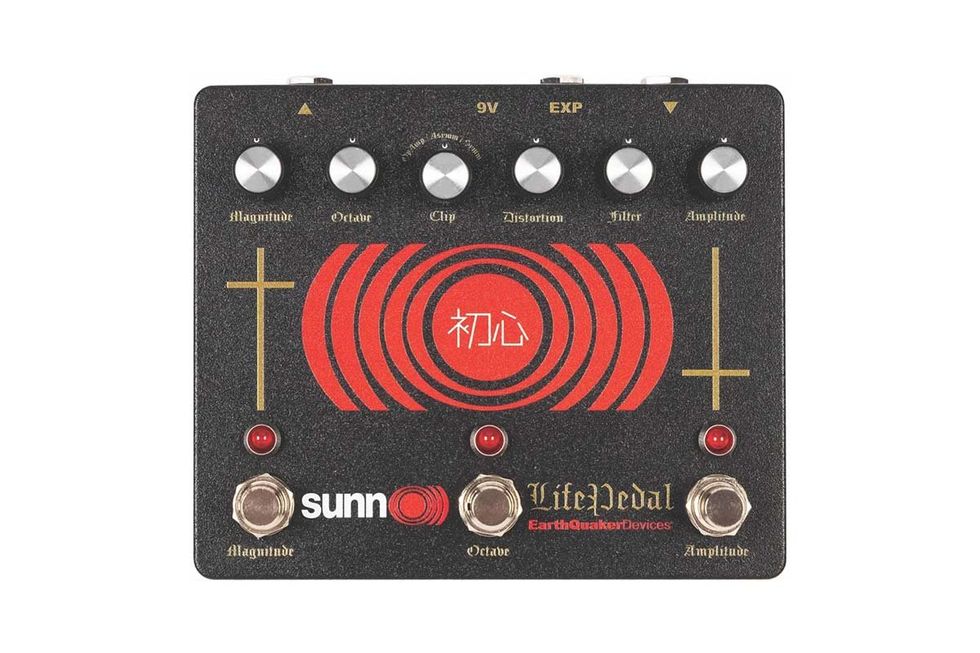Sunn O))) are a magnificent thing to behold live. The band’s drop tunings and henge of Sunn Model T amps generate sound waves that you feel as much as you hear. Sunn O)))’s heaviness can even have physiological effects. I’m pretty sure that I dozed off, momentarily, and quite involuntarily, leaning on the stage at a Sunn O))) show—bludgeoned to slumber by some sub-frequency lullaby they wove into a drone.
When experiencing the sound of Sunn O))), it seems funny to imagine anything so pitifully small as a stompbox having much influence on its almost planetary mass. But for much of their career, the humble Pro Co RAT was a foundational part of their recipe for hugeness. It also informs the basic architecture of the Sunn O))) Life Pedal V3 reviewed here. To the uninitiated, the Life Pedal V3 probably looks like a one-dimensional tool for generating heaviness. In fact, it’s a distortion unit that’s versatile beyond its most obvious applications.
Crack the Earth
The distortion or “amplitude” side of the pedal—which approximates the sound of the early RATs used by Stephen O’Malley and Greg Anderson—is a really nice take on the type. First, it’s loud, with bucketloads of headroom. Though there’s more gain in the Life Pedal V3 than in my circa-1990 RAT, it also feels a lot less compressed, all without compromising the essential RAT-tiness of its voice. The Life Pedal’s distortion is also smoother, and I hear more range in the filter control, which is such a key to a RAT’s versatility. Like a lot of RAT-type pedals, the Life Pedal lacks the searing top-end that distinguishes a lot of ’60s fuzzes or distortions along the lines of the MXR Distortion + family. But there is great balance across the EQ spectrum. It’s particularly well suited to communicating detail in chords. Arpeggios snap with a lively edge. And chugging punk and Thin Lizzy rhythm bits sound awake and punchy. It’s also well suited for the more clangorous tones you associate with ’90s indie-spectrum RAT users. And it’s a great way to generate heaviness in a track without being overbearing or clogging up a mix.
It’s articulate, relatively touch sensitive, and loves a Telecaster bridge pickup as much as a woolly neck PAF.
Clip and Rip
The Life Pedal V3 features three clipping modes: symmetrical, asymmetrical, and no diode. Each affects the voice of the amplitude section profoundly, and each opens up very different tone horizons. The no-diode mode is incredibly loud, and extra insanely, incredibly loud if you add the boost. It can be devastating at high gain levels. But the no diode mode is also the key to unlocking the sweetest and most dynamic low-gain tones. The amplitude circuit shines in the no-diode setting, and snaps and barks in a very naked and amp-like way. It’s articulate, relatively touch sensitive, and loves a Telecaster bridge pickup as much as a woolly neck PAF. It’s an awesome setup for jangling rhythm, but better still for old-school, unadorned leads that cut to the bone. The asymmetrical diode setting is still loud, but adds grind and compression at the expense of some output and touch dynamism. The symmetrical mode is the most compressed and the quietest of the three, but it is easy to boost with the magnitude circuit, in the unlikely event that greater output levels on the amplitude side are inadequate.
The octave function, which is partly derived from the octave section in a Shin-Ei FY6 Super Fuzz circuit, adds high-octave content. It was a feature on earlier iterations of the Life Pedal. But on the V3 it has its own dedicated soft-relay footswitch. Better still, there is now an expression pedal jack that enables you to blend octave in and out of the signal in all kinds of tasteful and/or demented ways. The circuit was tweaked a bit to the let bass content from the amplitude section breathe more readily, and the combined amplitude and octave settings are very balanced as a consequence. Chords are articulate and clear with the octave in the mix, even at very advanced settings. Typically, octave pedals splinter chords into a glitchy mess. And while the Life Pedal’s octave isn’t the boldest sounding in the world, the fact that you can preserve so much chord detail while retaining the menacing, chaotic presence of the octave extends the practical functionality of the Life pedal considerably. It’s easy to understand how this blend would be an asset to Sunn O))), depending, as they do, on sustained chords and waves of shifting overtones. But the possibilities for spicing up chord riffs, doubling leads, or creating a tight, punchy, and complex tone picture via an A/B amp rig are pretty thrilling.
The Verdict
Don’t let the black magick graphics fool you. EarthQuaker’s Life Pedal V3 transcends doom. This is a flexible distortion that spans creamy, detailed rhythm textures, super-hot lead tones, and glitchy, fractured shards of octave fuzz. It’s fantastically loud, and if you have a high-headroom amp it will shake walls, windows, and foundations and remain surprisingly articulate. But it can also transform low- to mid-power amps in a Jekyll and Hyde fashion without driving them to collapse in a compressed mass of tone glop. The power of the Life Pedal should not be underestimated—nor should its versatility. This is a pedal of many, many potent personalities and voices.





















